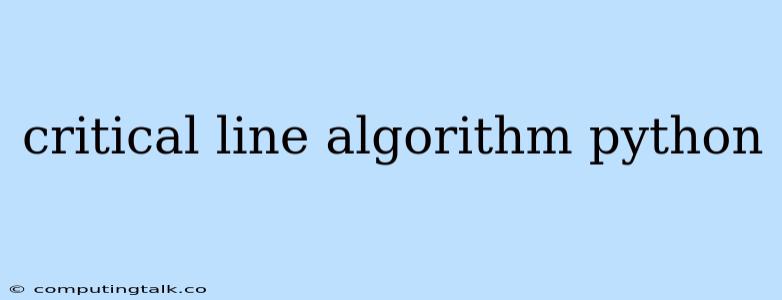The critical line algorithm is a powerful tool in the field of optimization, particularly for solving linear programming problems. In Python, this algorithm can be implemented efficiently using libraries like scipy.optimize. This article will delve into the intricacies of the critical line algorithm, exploring its core principles, implementation details, and practical applications.
What is the Critical Line Algorithm?
The critical line algorithm is a method for solving linear programming problems that involves systematically exploring the edges of the feasible region, known as "critical lines," to find the optimal solution. It is an iterative method that starts at a feasible point and moves along these critical lines until it reaches a point where no further improvement in the objective function is possible.
How Does It Work?
- Initialization: The algorithm begins by choosing an initial feasible point within the feasible region.
- Edge Exploration: The algorithm then moves along the edge of the feasible region, exploring different critical lines. This movement is guided by the direction of improvement in the objective function.
- Optimality Check: At each point along the critical line, the algorithm checks if the current solution is optimal. If not, it continues moving along the critical line in the direction that yields the best improvement.
- Iteration: This process of edge exploration and optimality checking continues until the algorithm reaches a point where no further improvement is possible. This point represents the optimal solution to the linear programming problem.
Implementing the Critical Line Algorithm in Python
The implementation of the critical line algorithm in Python can be achieved using the scipy.optimize library. This library provides the linprog function, which uses a variant of the simplex method to solve linear programming problems.
Example Code:
from scipy.optimize import linprog
# Define the objective function coefficients
c = [-1, -2]
# Define the constraints
A = [[1, 1], [1, -1], [1, 0]]
b = [4, 2, 3]
# Define the bounds for the variables
bounds = [(0, None), (0, None)]
# Solve the linear programming problem
result = linprog(c, A_ub=A, b_ub=b, bounds=bounds)
# Print the optimal solution
print(result.x)
In this example, c represents the coefficients of the objective function, A represents the constraint matrix, b represents the constraint vector, and bounds represents the bounds for the variables. The linprog function solves the problem and returns the optimal solution, which is stored in the result.x attribute.
Advantages of the Critical Line Algorithm
The critical line algorithm offers several advantages:
- Efficiency: The algorithm is generally efficient, particularly for problems with a small number of variables and constraints.
- Guaranteed Optimality: The algorithm guarantees that it will find the optimal solution to the linear programming problem if one exists.
- Simplicity: The algorithm is conceptually simple and easy to understand.
Limitations of the Critical Line Algorithm
Despite its advantages, the critical line algorithm also has some limitations:
- Large Problems: The algorithm can become computationally expensive for problems with a large number of variables and constraints.
- Degeneracy: In cases of degeneracy, where multiple constraints intersect at a single point, the algorithm may encounter difficulties.
- Non-Linear Programming: The algorithm is not directly applicable to non-linear programming problems.
Applications of the Critical Line Algorithm
The critical line algorithm finds wide application in various fields, including:
- Operations Research: Optimal resource allocation, scheduling, and production planning.
- Finance: Portfolio optimization and risk management.
- Engineering: Design optimization and structural analysis.
- Machine Learning: Feature selection and parameter tuning.
Conclusion
The critical line algorithm is a valuable tool for solving linear programming problems, offering efficiency, guaranteed optimality, and simplicity. Its implementation in Python using the scipy.optimize library provides a powerful and user-friendly approach for tackling optimization challenges in various domains. While it does have limitations, such as potential inefficiency with large problems and in degenerate cases, its strengths make it a widely used technique in optimization and related fields.
